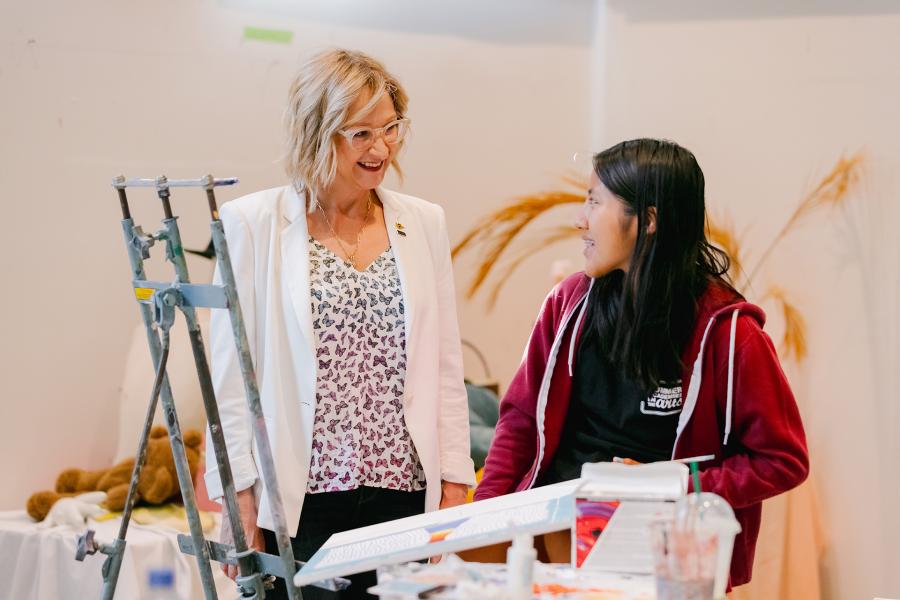Creative Wayfinding
Roadmaps in the Claire Trevor School of the Arts guide students to artistic success
By Christine Byrd
When emerging artists come to the Claire Trevor School of the Arts, they encounter more than an art school. Students find themselves at a top-10 public research university nestled in Orange County’s vibrant natural and cultural ecosystem.
“We want students who come here to understand that they have this extraordinary landscape, and we want to give them creative wayfinding so that they can be intentional about optimizing the opportunities — and understand how we’re different than any other arts school,” explains Tiffany Ana López, dean of CTSA.
The notion of creative wayfinding draws on a popular practice of helping people orient themselves in large and unfamiliar environments, like color-coded directions in an airport, or a digital app in an amusement park. Cultivating creative leaders requires creatively signaling the way.
“We’re painting a roadmap of activities and touchpoints all across the Claire Trevor School of the Arts and in the community in a way that’s both intentional and design-minded,” López says. “Creative wayfinding makes legible the opportunities and pathways available to students.”
López points to life-changing examples of wayfinding in her own career. First, a mentor encouraged her to become a professor when she was just an undergraduate. Then, when she was an assistant professor at the start of her career in academia, a UC leadership academy planted the seeds for her to become a future administrator. López now wants to facilitate these kinds of significant directional moments for arts students at UCI.
“Students come to us knowing that they are artists, so it’s very important for us to shape them in their journey not only as artists but to help them become creative leaders — whether that’s running a foundation, starting a podcast or joining professional projects,” López says. “When our students can tap into creative wayfinding, it’s like rocket fuel, taking them farther faster.”
Image (top): Dean Tiffany López visits with a student at the 2023 Summer Academies in the Arts. (Photo: Will Tee Yang)
Lonnie Alcaraz
Professor, Department of Drama
Since the 1990s, when Lonnie Alcaraz was an M.F.A. student in the Claire Trevor School of the Arts, he sought opportunities for artists of color to connect and share their stories on stage. His professional work as a lighting designer with South Coast Repertory’s Hispanic Playwrights Project and the founders of the comedy troupe Culture Clash, furthered his connection to his own Mexican heritage — and fueled his desire to share that with drama students. So, after returning to UCI as a faculty member, Alcaraz founded Brown Bag Theatre in 2009, giving voice to Latinx students and providing ample opportunities to network with industry professionals.
Since its first production, Loa to Divine Narcissus in 2011, the troupe has grown into a robust group of 20-30 students, mostly undergraduates, who choose shows to produce each year and create new works.
“Our students get exposed to a lot of plays and companies from the Latinx theater world, and they discover there’s a rich history there,” says Alcaraz, professor of lighting design. “We’re educating them on where they come from, and that helps them develop a focus, an identity.”
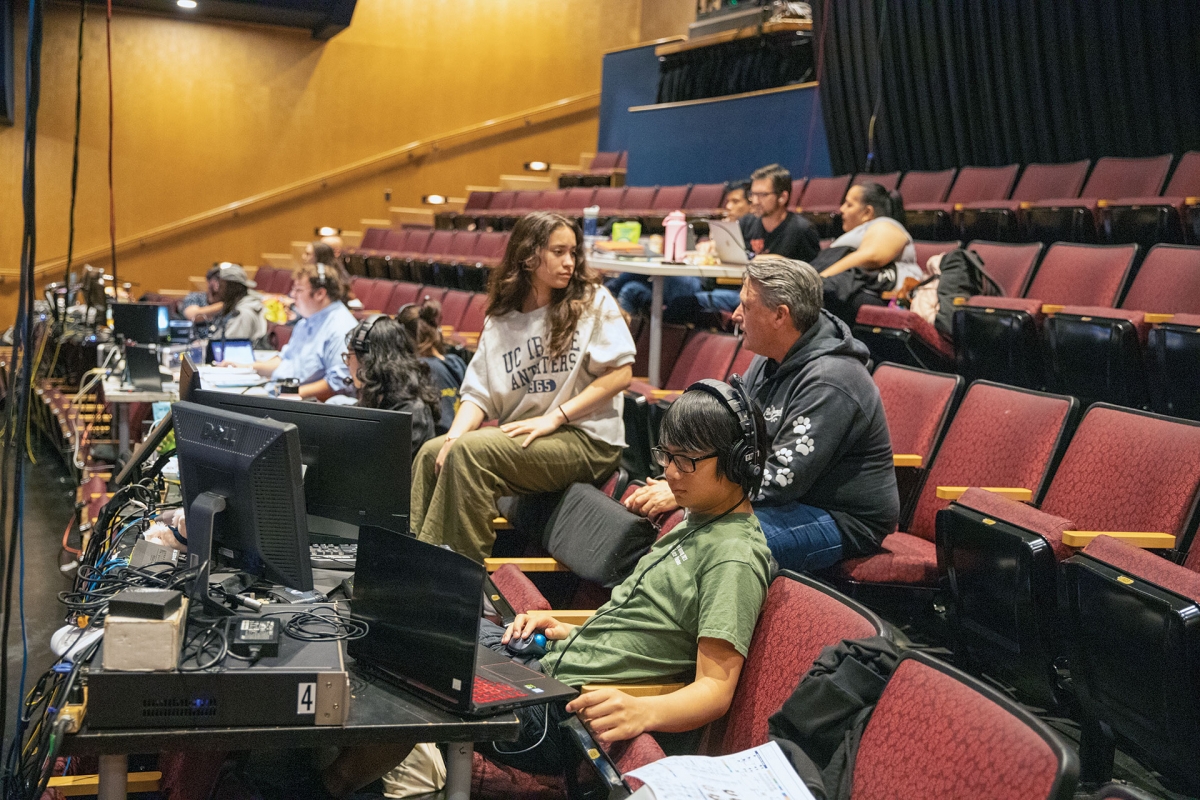
Image: Lonnie Alcaraz (right) mentors his lighting design students during a rehearsal for the spring 2023 musical, RENT.
Despite her Mexican-American heritage, Heather Lee Echeverria, ’20, M.F.A. ’23, had never played a Latinx character on stage until she joined Brown Bag Theatre. Once she did, it transformed her notions of what she could do with her art.
“After shows, students would come up to us and say they’d never seen their stories told on stage before and how impactful it was for them,” Echeverria says. “As a theater artist, I realized I want to make sure those stories are told — and my career is shifting a little because I want to do that.”
Alcaraz, who still works professionally as a lighting designer, has the connections to bring some of the shining stars of the Latinx theater world to meet with UCI students. Recent Brown Bag guests include playwrights Luis Alfaro, José Cruz Gonzalez and Karen Zacarías as well as Culture Clash co-founders Herbert Siguenza and Ric Salinas. There is also a growing network of Brown Bag alumni who now work professionally in theater and maintain ties to the organization that helped shape them.
“It’s not just the family aspect of Brown Bag and having that connection, but also there’s this huge network of people outside of UCI who are either alumni of the program or who know about and support our work,” says Echeverria.
Many of our alums are actively involved in their current jobs because of things they did while in Brown Bag.
Students with Brown Bag Theatre experience under their belt graduate with the skills and knowledge to put together an entire theater production from start to finish. Alcaraz matches students with faculty or graduate student mentors in playwriting, dramaturgy, production, direction, costume design, or whatever they need to succeed in staging their entirely student-led productions.
“Many of our alums are actively involved in their current jobs because of things they did while in Brown Bag,” says Alcaraz. “It’s such an important part of what they did while at UCI.”
Brown Bag Theatre members also help create the next generation of Latinx theatermakers. Each year, the group visits high schools in Costa Mesa, Santa Ana and Laguna Beach to talk about undergraduate life at UCI and share their experiences as drama students.
What Alcaraz is most proud of, though, is the leadership skills students like Echeverria develop through their involvement. After taking a backseat for her first two years in Brown Bag Theatre, Echeverria remembers Alcaraz approached her, “He said, ‘Heather, I want to see more leadership from you’ — and it catapulted me into all of this.”
“All of this” includes producing Culture Clash in AmeriCCa for Brown Bag in 2019, working with South Coast Repertory, and helping Alcaraz produce a community-engaged play for the Great River Shakespeare Festival in Minnesota over two summers. This summer, Echeverria was back at UCI performing in the New Swan Shakespeare Festival, before seeking her next professional theater job.
“Lonnie has set up Brown Bag as a place to really learn how the professional theater world works. If I ever needed to self-produce a show with other people, I could totally do that now,” Echeverria says. “Brown Bag has been so important to me throughout my entire journey.”
Image: Image: Lonnie Alcaraz (fat left) with the cast and crew of Brown Bag Theatre's production of Mojada, including Dean López, who mentored the show's student dramaturge.
Amanda Ross-Ho
Professor, Department of Art
As a sculptor preparing a gallery exhibition, a public art project, and a book — while simultaneously teaching in the Claire Trevor School of the Arts —professor Amanda Ross-Ho knows first-hand the delicate balancing act required of any working artist.
“One of the important aspects of being a research professor is that you’re not in theoretical space with your students; you’re holding the stakes as well,” Ross-Ho says. “I’m navigating many of the same things that they are, only at a slightly different phase of growth and development.”
Those who earn an M.F.A. from UCI may pursue any number of careers —professional artist, curator, faculty at an art school or even a scientist who leverages art. For many, building a successful life as an artist will require juggling multiple roles, just like Ross-Ho does as an artist and university professor.
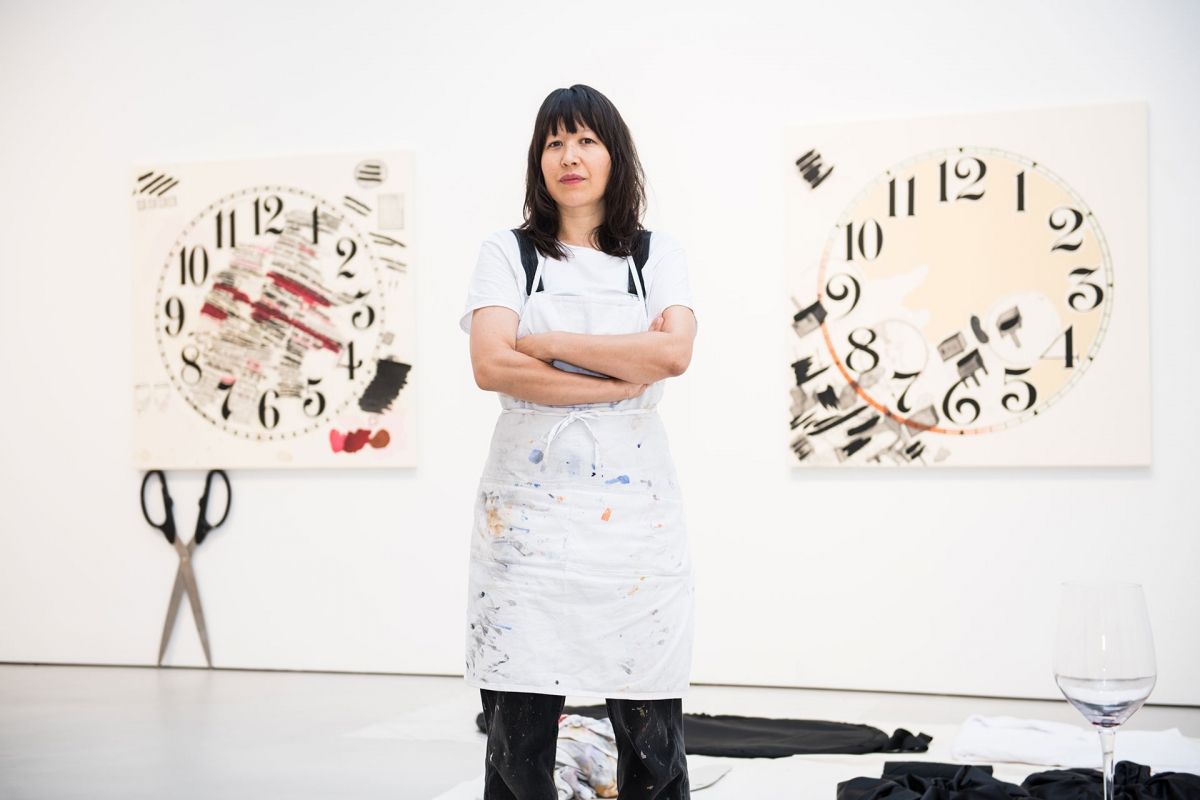
Image: Amanda Ross-Ho in her studio. (Photo: Teddy Wolff)
For each student, success as an artist may look different, and a crucial step in their creative wayfinding process is clarifying what kind of artistic life they want and how best to leverage their own skills and preferences to achieve it.
“There’s not a cookie-cutter way to set the goalposts for each student, because each person’s definition of success in the field is very personalized, and the field itself is not monolithic,” Ross-Ho explains.
For Ross-Ho, there is a constant push and pull between her roles as a teacher and mentor and life as a creator and artist. But this tension helps connect her deeply to her students.
“Mentorship isn’t just top-down,” she says. “I can offer professional and artistic experience, but really it’s about achieving enough understanding of one another that I can help them with their best path. It’s hard because it requires bravery for a student to go down a path that has not already been blazed.”
It’s hard because it requires bravery for a student to go down a path that has not already been blazed.
A sense of community can help students and alumni navigate the inherent challenges of building an artistic life and blazing a new path. Ross-Ho notes that several recent graduates have established spaces in Southern California such as Phase Gallery and After Hours Gallery where they show each other’s work, hold intramural critiques, and continue dialogues that they began as students.
“A lot of friendships that start in grad school become very strong because these are the people who were witnesses to your own growth, and they become part of your artistic network in the future,” Ross-Ho says. “This is important because art production isn’t only making objects and placing them on display. There are the discursive, community and world-building aspects, too.”
To create an ideal artistic life, Ross-Ho urges students to think about their specific requirements for producing their best work as artists. Are you a morning person or a night owl? Do you thrive in social settings or solitude? Does the buzz of the city invigorate you, or do you prefer the solitude of nature?
“What, truly, are the conditions that help you make your best work?” she says. “It’s not just more space, more time, more money. Sometimes an economy of means allows us to respond to limitations and makes us more productive.”
“With art, the name of the game is sustainability,” she adds. “Part of what you figure out is not just how you will make art but how you will sustain that socially, emotionally, as a person.”
Ultimately, guiding art students through the process of creating their own artistic practice helps ensure Ross-Ho follows her own advice in fostering an artistic life.
“It’s important to be an example to my students and to hold myself up against the same standards that I’m asking of them,” she says. “It raises my sense of urgency to keep generating and moving forward with my own work, knowing we’re in mutual commitment to one another.”
Sarah Koo Freeman
Lecturer, Department of Music
As a resident assistant at The Juilliard School on 9/11, Sarah Koo Freeman helped her classmates evacuate their dorms safely. Then, desperate to do something to help in the crisis and chaos, she led her fellow musicians with their instruments to play outside the armory where families were waiting for news of their loved ones.
“We tried to bring solace and comfort through music,” she says. “There really is outreach that can be done with music, and I want to impart that to every generation.”
Now, as a lecturer in the Department of Music, Koo Freeman brings that lesson to the Claire Trevor School of the Arts.
During the Summer Academies in the Arts, 9-12 graders from around Southern California and even across the country come to UCI for a two-week chamber music intensive. Students experience playing music in the smaller grouping that distinguishes the genre from orchestra and gain new perspectives on the role of music in their lives.
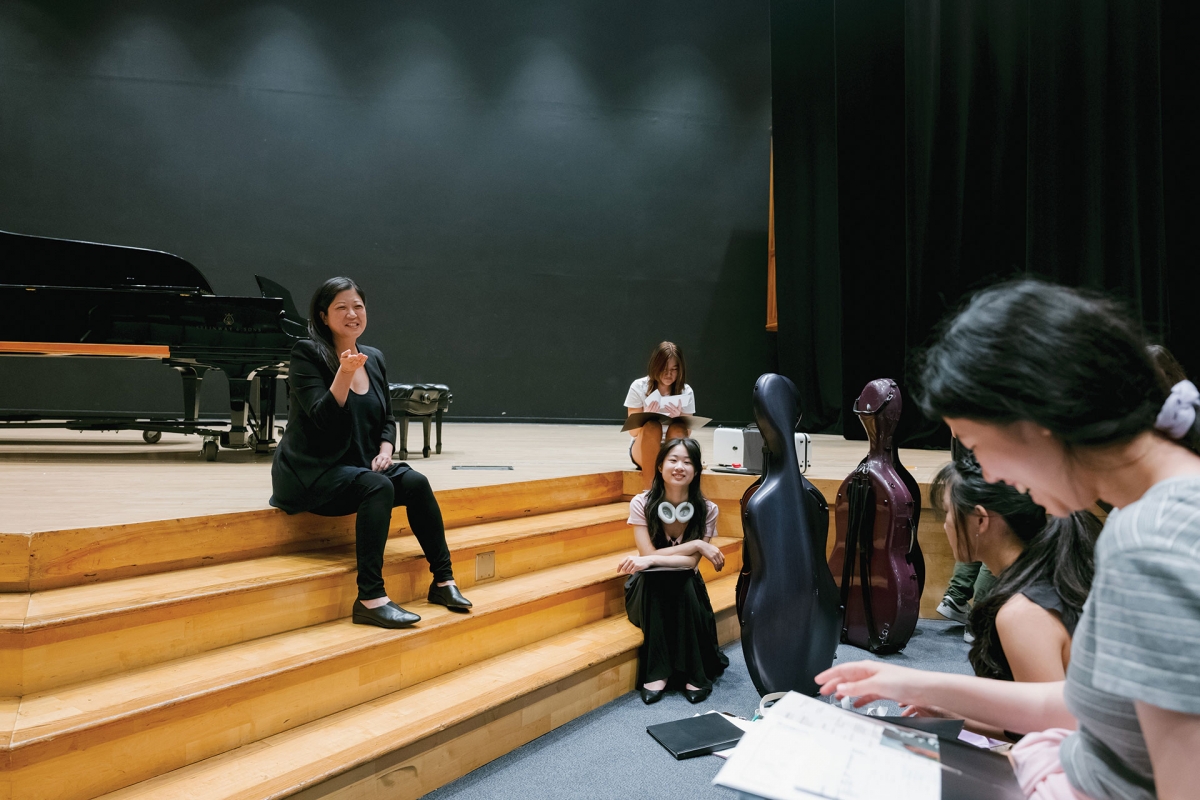
Image: Sarah Koo Freeman leads a class of 9th- to 12th-grade students in a two-week chamber music intensive at the 2023 Summer Academies in the Arts. (Photo: Will Tee Yang)
Koo Freeman discusses career development, and students build a portfolio with their resume, bio and headshot to use on college applications. She also talks to them about the transferable skills they are gaining as musicians.
“Myself and my colleagues have always had to be multifaceted in our music careers, so it’s important for students to know that every minute they are pouring into their musical studies is not one-dimensional,” says Koo Freeman. “If they decide not to play cello the rest of their lives, they are still learning skills that they can use to be a doctor or lawyer or any other career.”
It’s not only the high school students who benefit from the summer program.
“What excites me most about our program here, and what’s really unique, is that we incorporate our current UCI students as faculty,” says Koo Freeman. “We have this collaboration at all these different stages of a musician’s life —professional, college students and high school students.”
“It’s amazing to see our UCI students step into their own as teachers but also to be observing me leading classes and learning from that,” she adds.
UCI chamber music students engage in K-12 outreach throughout the academic year as well. Each quarter, a local high school group tours the campus and visits her chamber music class, where UCI students give a presentation about the composer and the piece they are learning before performing.
“We’re teaching our college students to educate others from the stage and to share music with our community,” she says.
We have this collaboration at all these different stages of a musician’s life – professional, college students and high school students.
Koo Freeman intentionally chooses works from lesser known and underrepresented composers — women like Jessie Montgomery and Reena Esmail — to introduce to her students and for them to perform for the younger students.
“We’re trying to expose the next generation to these fantastic works by underrepresented composers that should be in the canon next to Beethoven and Brahms but just aren’t,” she says. “We can preserve the beauty of the old while also forging new paths to challenge ourselves and challenge the next generation.”
Music, Koo Freeman believes, is a universal language; one that can bring hope and comfort. She’s known to UCI students for helping them use music in the community, such as raising money to help a fire department during California wildfires, or traveling to Las Vegas to play outside the site of the Route 91 mass shooting.
“There are moments that I hope music can be healing,” she says. “I want to impart to every generation that comes through — whether that’s K-12 students or our college students — that they have the power to use music as a means of outreach and connection in the community.”
Charlotte Griffin
Assistant Professor, Department of Dance
Charlotte Griffin, assistant professor of dance, poses a question to first-year students in the Modern 2 class each year: What are you doing over the summer? As they go around the circle, most of the students share their plans for summer jobs.
Then, Griffin tells them about UCI’s Undergraduate Research Opportunities Program (UROP), Summer Undergraduate Research Program (SURP), the Medici Scholarship funded by Claire Trevor School of the Arts donors, and opportunities through local arts councils or other scholarship programs that could advance their dance education through the summer.
A dance teacher is like a textbook, Griffin explains. Students need exposure to as many different ones as possible as they create their own life in dance.
“We talk about what intensive study means, and how with the embodied knowledge of dance, you’re studying in depth with one teacher, one text, and it behooves you to go to other texts or other teachers,” Griffin explains.
She also encourages students to consider opportunities such as working as a counselor for young dancers in a summer program and, in exchange, receiving reduced tuition for the pre-professional program. Or exploring work-study roles in productions.
The following year, in the Modern 3 class, Griffin again asks the question of her students.
“At that point, they always blow my mind because they’ve started their own wayfinding,” she says. “Many have UROP or SURP funding, they’re doing not just one but two or even three summer intensives. They’re creating new artistic networks, and they’re inspired.”
Frankie Peji, a third-year dance major, completed three intensives this summer: Open Doors North America, LA Contemporary Dance Company and Au.thenticity Dance Company, all with scholarships or a discount.
They've started their own wayfinding. They're creating new artistic networks, and they're inspired.
“I enjoy soaking up lots of new information and dancing with lots of new people,” says Peji. “The summer intensives helped me form new opinions on movement that are different than what I get from my training at UCI.”
The dance curriculum at UCI, which requires students to take classes in modern, ballet, jazz and hip-hop, has also expanded Peji’s horizons. Although she came to UCI focused on commercial dance, she says her modern dance classes and performing in a modern piece in Dance Visions last year have caused her to shift that focus slightly.
“The dance department does a great job of allowing dancers to explore different opportunities through courses, performance opportunities, and giving us time to explore classes in L.A. or O.C.,” she adds. “I feel that I’ve grown so much from the experiences in the work I do outside of the Claire Trevor School of the Arts throughout the year.”
The change in dancers upon their return from summer intensives is subtle but profound.
“Their focus is sharper, their motivations are more independent, their aesthetic horizons have expanded, they are more seasoned,” Griffin says. “It’s a beautiful growth and development process.”
While many UCI dance majors choose professional careers in concert dance, musical theater or commercial dance, others earn certificates in pilates or yoga or pursue arts administration. Some double major in areas including psychology, education and sciences, preparing them for diverse careers across sectors.
“Our students are really smart and incredibly hardworking, and many activate a dual profile as dancers,” Griffin says.
No matter the career path that students ultimately pursue, the skills honed as dancers will serve them well.
“Dancers develop persistence, resilience, creative problem solving, and capacity for collaboration and self-reflection that apply to many areas of life,” Griffin says. “As dancers, we’re sharing breath, we’re sharing motion, we’re sharing space, in a way that requires both individual responsibility and collective unity. That’s really a foundation for all of life.”
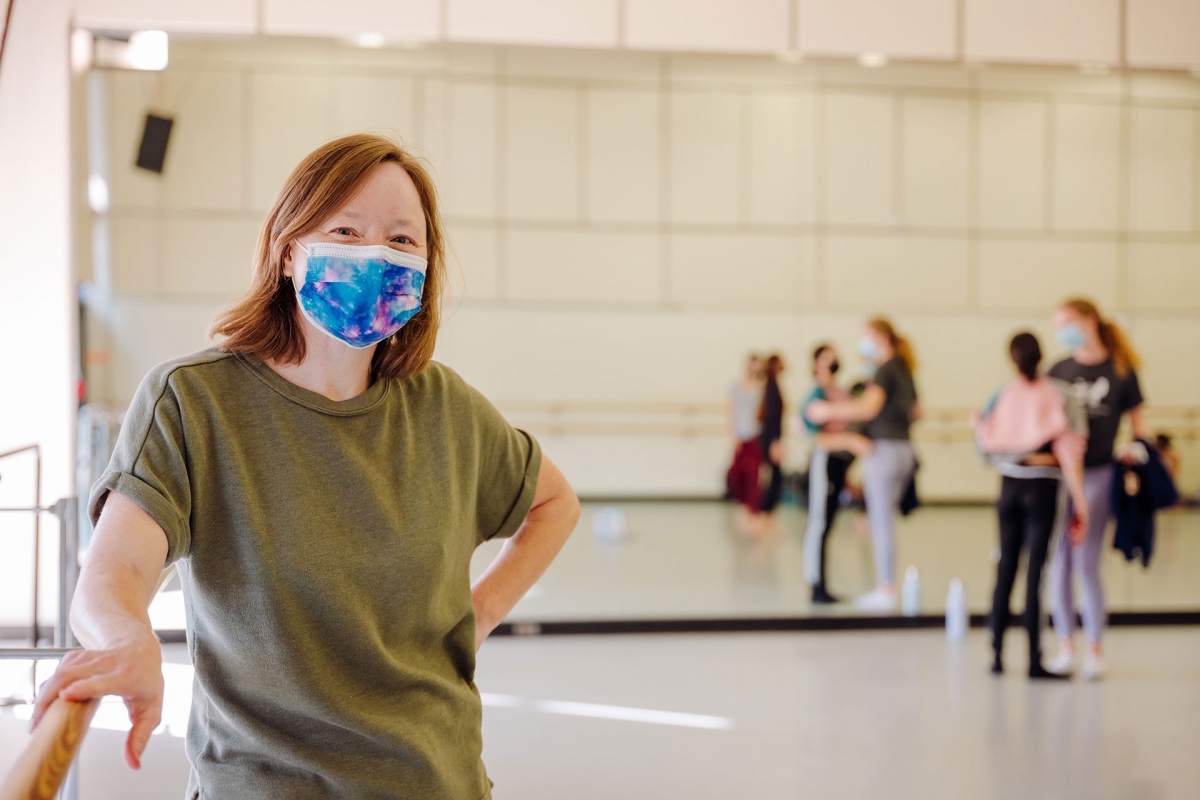
Image: Charlotte Griffin teaches a choreography class after classes resumed on campus in 2021. (Photo: Will Tee Yang)
Learn more about the various department programs and faculty at www.arts.uci.edu.
Please visit our secure direct giving page and make a gift today!

